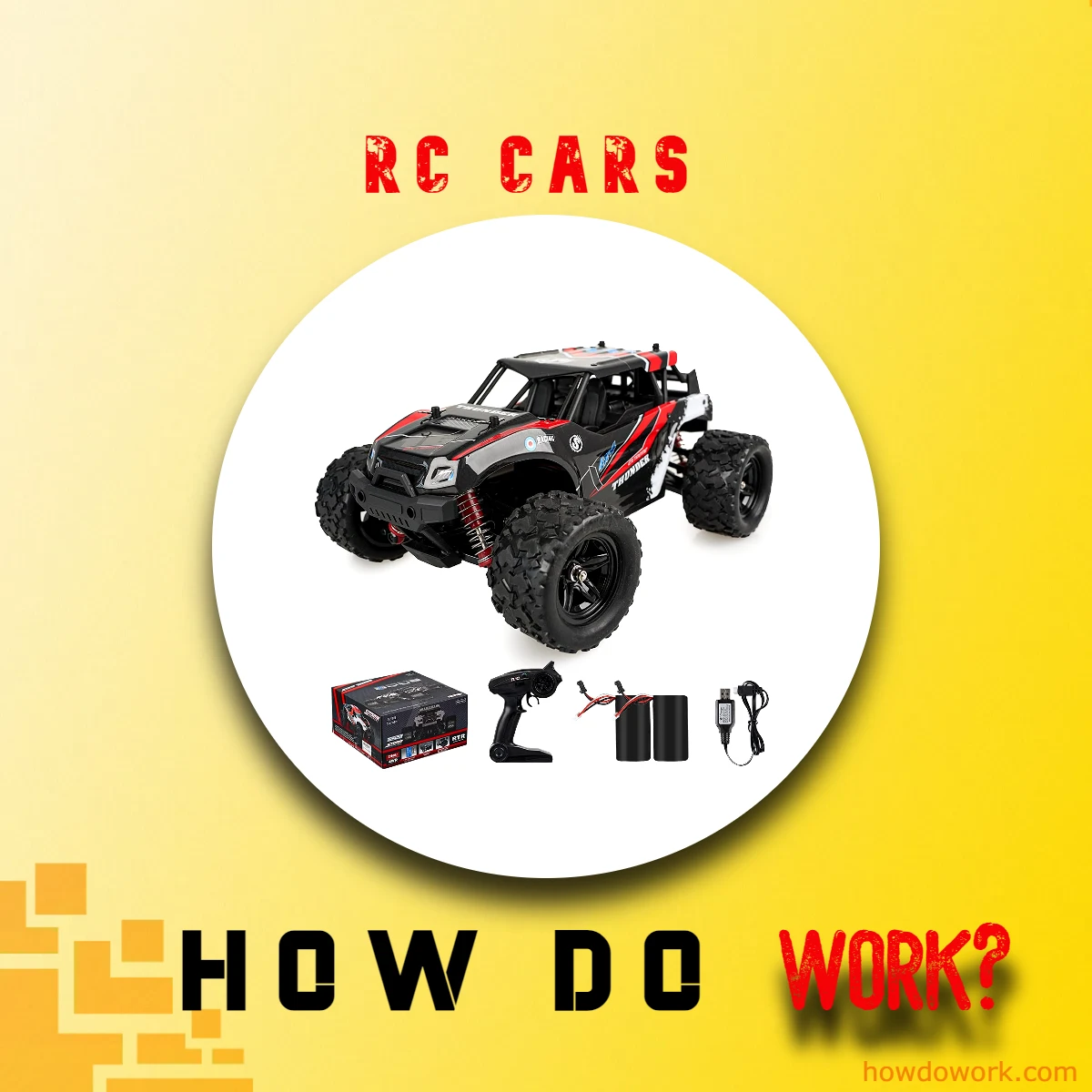
RC cars operate through a combination of intricate components and systems that enable their functionality. These miniature vehicles come in various types, including electric, nitro, gas-powered, and off-road models, each with its unique mechanism. Electric RC cars harness the power of rechargeable LiPo batteries to drive electric motors, providing a quieter and cleaner experience. In contrast, nitro RC cars feature internal combustion engines fueled by a mixture of nitromethane and methanol, delivering a realistic engine sound and higher speeds. Gas-powered RC cars run on gasoline, offering extended runtimes and strong performance. Off-road RC cars, built for rugged terrain, combine electric or internal combustion power with robust suspension systems and specialized tires. In essence, RC cars are a fusion of cutting-edge technology, engineering prowess, and a dash of passion, resulting in captivating miniature vehicles that offer endless excitement to enthusiasts and hobbyists of all ages.
| Aspect | Electric RC Cars | Nitro RC Cars | Gas-Powered RC Cars | Off-Road RC Cars |
|---|---|---|---|---|
| Power Source | Rechargeable LiPo batteries | Nitromethane and Methanol fuel | Gasoline | Rechargeable LiPo batteries or Gasoline |
| Motor Type | Electric motor | Internal combustion engine | Internal combustion engine | Electric motor or Internal combustion engine |
| Sound | Quiet | Realistic engine sound | Realistic engine sound | Varies (depending on type) |
| Maintenance Complexity | Low | Moderate to High | Moderate to High | Moderate to High |
| Startup Time | Almost Instant | Requires priming and tuning | Requires priming and tuning | Almost Instant (Electric) to Requires priming and tuning (Gas) |
| Speed | Generally slower than nitro and gas | Faster than electric, slower than gas | Faster than electric and nitro | Varies (some designed for speed, others for off-road capability) |
| Runtime | Limited (typically 10-20 minutes) | Moderate (15-30 minutes) | Moderate (20-40 minutes) | Varies (typically shorter than on-road RC cars) |
| Fuel Costs | None | Moderate | Moderate | Varies (fuel or electricity costs) |
| Emissions | No emissions | Exhaust emissions | Exhaust emissions | Varies (electric models have no emissions) |
| Customization Potential | High | Moderate | Moderate | High |
| Terrain Compatibility | Versatile | Typically on-road or flat surfaces | Typically on-road or flat surfaces | Versatile (designed for off-road use) |
| Learning Curve for Beginners | Low | Moderate to High | Moderate to High | Moderate to High |
| Price Range (Entry-Level) | Affordable | Moderate | Moderate to High | Moderate to High |
| Popular Brands | Traxxas, Losi, Tamiya, Arrma | Traxxas, HPI Racing, Redcat | Losi, Team Associated | Traxxas, Axial, Redcat, Arrma |
| Common Applications | General RC car enthusiasts, indoor and outdoor driving | Racing, experienced hobbyists | Racing, experienced hobbyists | Off-road enthusiasts, trail driving, crawling |
| Notable Models | Traxxas Rustler, Team Associated B6, Arrma Senton | Traxxas T-Maxx, HPI Savage, Redcat Earthquake | Losi 5IVE-T, Team Associated RC8 | Axial SCX10, Traxxas TRX-4, Redcat Everest 10 |
Contents
How RC Cars Work?
In the ever-evolving world of remote-controlled vehicles, the intricate mechanisms that propel these miniature marvels have long captivated the imaginations of enthusiasts and hobbyists alike. The question that often arises is this: How do RC cars work?
As we venture deeper into the realm of RC cars, you will discover that these captivating machines come in various forms, each with its unique characteristics and engineering feats. Whether you’re drawn to the electrifying swiftness of electric RC cars, the primal roar of nitro-powered beasts, the endurance of gas-powered champions, or the off-road prowess of rugged off-road models, there is an RC car tailored to your desires and preferences.
Understanding the RC in RC Cars
RC stands for “remote control,” which is the heart and soul of these miniature vehicles. At its core, an RC car is a scaled-down replica of a real car, complete with wheels, a chassis, and a motor. The key difference is that instead of a driver, you take the wheel using a handheld transmitter, allowing you to navigate your RC car with precision.
The Four Main Types of RC Cars
Before delving into the mechanics, it’s important to note that there are four main types of RC cars, each with its unique characteristics:
- Electric RC Cars: These are perfect for beginners due to their simplicity and ease of use. Electric RC cars are powered by rechargeable batteries, making them quiet and environmentally friendly. They come in various sizes and are great for indoor and outdoor use.
- Nitro RC Cars: Nitro RC cars are known for their speed and realism. They run on a mixture of nitromethane, methanol, and oil, offering a more authentic engine sound and increased power. They require more maintenance but provide an adrenaline-pumping experience.
- Gas-Powered RC Cars: Similar to nitro cars, gas-powered RC cars use gasoline as fuel. They are often larger in size and are favored by experienced hobbyists who enjoy tinkering with engines and tuning their cars for optimal performance.
- Off-Road RC Cars: These rugged machines are designed for rough terrain, such as dirt tracks, rocky paths, and even mud. They have durable tires and suspension systems that can handle the toughest challenges.
Now, let’s dive into the core components of an RC car.
The Anatomy of an RC Car
RC cars may be small, but they are intricate pieces of engineering. Here are the main components that make up these miniature marvels:
| Component | Function |
|---|---|
| Chassis | The chassis is the frame of the RC car, providing structural support and housing for all other components. It comes in various designs, such as tub, plate, and monocoque. Materials can range from plastic to high-quality aluminum for improved durability. |
| Wheels and Tires | The wheels and tires determine the RC car’s traction, stability, and handling. Different tread patterns and rubber compounds are used to optimize performance on various surfaces, such as pavement, grass, or dirt. |
| Motor | The motor is the powerhouse of the RC car. In electric RC cars, it converts electrical energy from the battery into mechanical energy to drive the wheels. In nitro and gas-powered cars, the motor is an internal combustion engine that runs on fuel. The type of motor greatly influences speed and performance. |
| Transmission | The transmission transfers power from the motor to the wheels. It includes gears and a clutch system, which allows you to control speed and acceleration. Many RC cars offer adjustable gear ratios for fine-tuning performance. |
| Suspension | The suspension system consists of shocks, springs, and linkages that connect the wheels to the chassis. It absorbs bumps and impacts, ensuring a smoother ride and better handling. Suspension settings can be adjusted to suit different terrains and driving styles. |
| Electronic Speed Controller (ESC) | In electric RC cars, the ESC regulates the power supplied to the motor, controlling speed and direction. It interprets signals from the transmitter and translates them into motor commands. Modern ESCs often have programmable features for customization. |
| Radio Receiver | The radio receiver is the “ears” of your RC car, receiving signals from the transmitter and transmitting them to the ESC and steering servo. It operates on a specific radio frequency, usually 2.4GHz, to ensure reliable communication between the controller and the car. |
| Steering Servo | The steering servo is responsible for turning the front wheels of the RC car. It receives commands from the transmitter and adjusts the wheel’s position accordingly. High-quality servos offer precise control for accurate steering. |
| Battery/Power Source | Electric RC cars rely on rechargeable batteries for their energy source. The choice of battery affects runtime and performance. Lithium-polymer (LiPo) batteries are popular due to their high energy density. Nitro and gas-powered cars use their respective fuels for power. |
| Body Shell | The body shell is the outer shell of the RC car, providing the vehicle’s aesthetics and aerodynamics. It is often customizable, allowing hobbyists to choose their preferred style and design. Some body shells are made from polycarbonate for flexibility and durability. |
How RC Cars Work: The Process
Now that we’ve dissected the components of an RC car, let’s walk through the step-by-step process of how these mechanical marvels come to life:
- Power Source: The journey begins with the power source. In electric RC cars, this is the rechargeable battery pack. When you turn on your transmitter, it sends a signal to the receiver in the RC car.
- Receiver Reception: The receiver, located inside the RC car, picks up the signals from the transmitter. These signals are coded with information about throttle, steering, and other functions.
- ESC Interpretation: The electronic speed controller (ESC) plays a crucial role in interpreting the signals received from the receiver. It determines the speed and direction based on your input and translates this information into commands for the motor.
- Motor Magic: In electric RC cars, the motor springs to life, converting electrical energy from the battery into mechanical energy. This energy drives the wheels, propelling the car forward or backward, depending on your commands.
- Steering Sensation: Simultaneously, the steering servo receives signals from the transmitter, making minute adjustments to the front wheels’ position. This precise control allows you to navigate corners and obstacles with ease.
- Suspension’s Role: As the RC car races along, its suspension system takes on the task of smoothing out the ride. Shocks and springs absorb the shocks from bumps and jumps, ensuring the wheels maintain contact with the ground.
- Tire Traction: The wheels and tires play a pivotal role in maintaining traction with the surface. Different tread patterns and rubber compounds optimize grip, allowing the RC car to handle various terrains effectively.
- Transmission Transition: Inside the transmission, gears and clutches work together to control speed and acceleration. Adjusting gear ratios can fine-tune the RC car’s performance to suit different scenarios.
- Body Beauty: Finally, the body shell not only adds a dash of style but also influences aerodynamics. A well-designed body can enhance stability and reduce air resistance, allowing for smoother and faster rides.
And there you have it – the intricate dance of components and systems that make RC cars come to life. But the world of RC cars is constantly evolving, with new technologies and innovations pushing the boundaries of what these tiny vehicles can achieve.
Advanced RC Car Technologies
Brushed vs. Brushless Motors
One of the key advancements in electric RC cars is the transition from brushed to brushless motors. Brushed motors use physical brushes to transfer electricity to the spinning rotor, resulting in friction and wear over time. In contrast, brushless motors use electronic commutation, eliminating brushes and significantly increasing motor efficiency and lifespan. They offer higher speeds and longer runtimes, making them a favorite among enthusiasts.
LiPo Batteries
Lithium-polymer (LiPo) batteries have revolutionized the world of RC cars. They are known for their high energy density, allowing for smaller and lighter battery packs that deliver impressive power. LiPo batteries also provide a consistent voltage output, maintaining performance throughout the entire runtime. However, proper care and charging are essential to prevent safety hazards, as LiPo batteries can be volatile if mishandled.
2.4GHz Radio Systems
Older RC cars often used AM or FM radio frequencies for communication between the transmitter and receiver. However, modern RC cars utilize 2.4GHz radio systems, which offer several advantages. They provide a more reliable and interference-free connection, allowing multiple RC cars to operate in close proximity without signal interference. Additionally, they are less susceptible to signal loss due to obstacles.
Ready-to-Run (RTR) and Kit Models
RC car enthusiasts have the option to choose between ready-to-run (RTR) models and kit models. RTR cars come fully assembled and are ready to use right out of the box, making them ideal for beginners. Kit models, on the other hand, require assembly from individual components, offering a more hands-on experience. Kits allow hobbyists to customize their cars to their liking and gain a deeper understanding of the vehicle’s mechanics.
Why do rc cars fail?
RC cars, like any mechanical devices, can experience failures or issues for various reasons. These failures can be attributed to a combination of factors, including wear and tear, user error, manufacturing defects, and environmental conditions. Here are some common reasons why RC cars may fail:
Wear and Tear: Over time, the various components of an RC car, such as gears, bearings, and suspension parts, can wear out due to regular use. This is a natural part of the lifecycle of any mechanical device.
Crashes and Accidents: RC cars are prone to crashes, especially if they are driven at high speeds or on challenging terrains. These collisions can lead to damage to the chassis, suspension, or other critical parts.
Improper Maintenance: Neglecting regular maintenance, such as cleaning, lubrication, and inspection, can lead to premature failures. Lack of maintenance can cause issues like rust, dirt buildup, and component wear.
Electrical and Electronic Issues: In electric RC cars, problems can arise with the electrical system, including issues with the battery, electronic speed controller (ESC), and radio receiver. Damaged wires, connectors, or solder joints can disrupt the electrical flow and lead to failures.
Battery Problems: LiPo batteries, commonly used in electric RC cars, require proper care and maintenance. Failure to charge, store, or balance these batteries correctly can result in damage or even safety hazards.
Manufacturing Defects: Occasionally, RC cars may have manufacturing defects that become apparent after some use. These defects can affect various components, including motors, gears, or electronics.
Overheating: Running an RC car for an extended period at high speeds or with aggressive driving can lead to overheating of the motor or electronic components. Overheating can cause damage and reduce the lifespan of these parts.
Environmental Conditions: The conditions in which you operate your RC car can impact its performance and longevity. Exposure to water, mud, sand, and extreme temperatures can lead to rust, corrosion, and electronic malfunctions.
User Error: Inexperienced users may make mistakes while operating or maintaining their RC cars. These errors can range from improper tuning of the engine (for nitro or gas-powered cars) to incorrect battery handling or even damaging the chassis during assembly.
Upgrades and Modifications: While many hobbyists enjoy customizing and upgrading their RC cars, improper modifications or installations can lead to issues. Incompatible parts or modifications that put excessive strain on the vehicle can cause failures.
Aging Components: As RC cars age, their components may become less reliable. This can include weakened springs, worn-out tires, or motors that have reached the end of their lifespan.
Electromagnetic Interference (EMI): In crowded areas with many RC cars operating simultaneously, EMI can disrupt radio signals between the transmitter and receiver, leading to loss of control and potential crashes.
To mitigate these issues and prolong the life of your RC car, it’s essential to practice proper maintenance, operate the vehicle within its capabilities, and take precautions when driving in challenging conditions. Additionally, investing in quality components and following manufacturer guidelines can help reduce the likelihood of failures. When issues do arise, it’s helpful to have a basic understanding of the mechanics and electronics of RC cars to diagnose and address problems effectively.
RC Car Maintenance and Tips for Beginners
Now that you’re well-acquainted with the inner workings of RC cars, it’s essential to discuss maintenance and offer some valuable tips, especially if you’re just starting in the hobby. Proper care ensures that your RC car performs at its best and lasts for a long time.
Maintenance Basics
Cleaning and Inspection
Regularly clean your RC car after each use. Dust, dirt, and debris can accumulate in various components, affecting performance. Inspect the chassis, suspension, and gears for any signs of wear or damage. Cleaning can be as simple as using a brush and compressed air to remove dirt and debris.
Lubrication
Proper lubrication of moving parts is crucial for reducing friction and preventing premature wear. Use appropriate lubricants for different components, such as silicone oil for shocks and bearings, and gear oil for transmission gears.
Battery Care
For electric RC cars, battery maintenance is essential. Always follow the manufacturer’s guidelines for charging and discharging LiPo batteries. Overcharging or discharging can lead to battery damage or even fire hazards. Store LiPo batteries in a fireproof bag or container when not in use.
Nitro and Gas Engines
If you have a nitro or gas-powered RC car, regular engine maintenance is crucial. This includes cleaning the air filter, checking fuel lines for leaks, and tuning the engine for optimal performance. It’s a good idea to have a basic understanding of engine mechanics or seek guidance from experienced hobbyists.
Tips for Beginners
Start Slow
If you’re new to RC cars, it’s best to start with a slower, more manageable model. High-speed vehicles can be challenging to control, and crashes at high speeds can result in more significant damage. Once you gain confidence and experience, you can upgrade to faster models.
Learn the Basics of Transmitter Controls
Understanding the functions of your transmitter is essential. Most transmitters have controls for throttle (acceleration and braking) and steering. Familiarize yourself with these controls and practice basic maneuvers like acceleration, braking, and steering in an open, obstacle-free area.
Safety First
Always prioritize safety when operating RC cars. Avoid running them in areas with heavy traffic or around pedestrians. Keep a safe distance from people, animals, and fragile objects to prevent accidents. Protective gear like goggles and gloves can be beneficial, especially when working on gas or nitro-powered models.
Learn from Others
Joining an RC car community or club can be a fantastic way to learn from experienced hobbyists. They can provide valuable advice on maintenance, tuning, and driving techniques. Plus, it’s a great opportunity to socialize with fellow enthusiasts who share your passion.
Budget Wisely
RC car hobby costs can add up quickly, especially if you’re into collecting or racing competitively. Set a budget and stick to it. Prioritize essential items like spare parts, maintenance tools, and safety gear. As you gain more experience, you can consider investing in upgrades and customization.
Cutting-Edge Thrills: A Review of the Latest Model RC Cars
In a world where technology continually pushes the boundaries of what’s possible, it’s fascinating to witness how the latest model RC cars are evolving to deliver an adrenaline-pumping experience like never before.
Unleashing Electric Precision:
The electric RC cars of today have taken precision to a whole new level. They are powered by high-performance LiPo batteries that provide not only speed but also extended runtimes. The electronic speed controllers (ESCs) offer seamless throttle control, enabling smooth acceleration and precise maneuvers. What’s truly remarkable is the integration of advanced technologies like gyroscopic stability systems, which keep these vehicles planted on the track, even at breakneck speeds. The result is a driving experience that’s both thrilling and accessible to enthusiasts of all skill levels.
Nitro’s Roar and Gasoline’s Stamina:
For those who crave realism and the visceral growl of engines, nitro and gas-powered RC cars are where the excitement lies. Nitro RC cars, with their internal combustion engines, offer a symphony of mechanical symphonies as they tear down the track. The latest models have refined tuning options, making them more accessible for newcomers while retaining their raw power. Gas-powered RC cars, running on regular gasoline, provide extended runtimes, allowing for longer sessions of heart-pounding action. The engineering behind these vehicles is nothing short of impressive, and the technology continues to evolve to provide a balance between performance and user-friendliness.
Off-Road Domination:
What truly sets the latest RC cars apart is their off-road prowess. These rugged machines are designed to conquer challenging terrains with ease. Whether it’s climbing over rocks, powering through mud, or tackling sand dunes, the latest off-road RC cars are a testament to innovation. With adjustable suspension systems, high-traction tires, and robust chassis designs, they can handle the most demanding environments. What’s more, the inclusion of advanced shock absorption technologies ensures a smoother ride and better control, even on the roughest of terrains.
In conclusion, the latest model RC cars are a testament to the marriage of technology and passion. Whether you prefer the precision of electric models, the roar of nitro engines, or the endurance of gas-powered vehicles, there’s a thrilling experience waiting for you. The advancements in stability, control, and off-road capabilities have elevated these miniature marvels to a new level of excitement.
FAQs
RC cars are powered by various sources, including electric batteries (LiPo or NiMH), nitromethane and methanol fuels (in nitro RC cars), or gasoline (in gas-powered RC cars). The power source drives the motor, propelling the vehicle.
Electric RC cars use rechargeable batteries (typically LiPo or NiMH) to supply power to an electric motor. The electronic speed controller (ESC) regulates the flow of electricity to the motor, controlling speed and direction based on signals from the transmitter.
Nitro RC cars use a specialized fuel mixture of nitromethane and methanol to power internal combustion engines. Gas-powered RC cars, on the other hand, run on gasoline. Both offer realistic engine sounds and higher speeds compared to electric models.
Off-road RC cars are designed for rough terrain and typically feature rugged suspension systems, larger tires with aggressive tread patterns, and higher ground clearance. On-road RC cars are built for smooth surfaces and prioritize speed and handling.
The transmitter is the handheld controller used to send signals to the RC car. It communicates with the receiver in the car, allowing the operator to control throttle, steering, and other functions.
Regular maintenance includes cleaning, lubrication, and inspection of critical components. Additionally, it’s essential to charge and store batteries properly, keep the car’s wiring in good condition, and perform routine checks on gears, suspension, and tires.
If your RC car is not responding, check the transmitter’s batteries, ensure it’s paired with the receiver, and inspect the wiring and connections in both the transmitter and the car.
To increase speed, you can consider upgrading the motor, battery, or gear ratio, depending on the type of RC car you have. Additionally, improving aerodynamics and reducing weight can enhance speed.
If the nitro engine won’t start, check the fuel mixture, ensure the glow plug is working, and follow proper priming and tuning procedures. It may also be helpful to consult the manufacturer’s manual.
Yes, RC cars are highly customizable. Enthusiasts often upgrade components like motors, ESCs, suspension, and bodies to enhance performance and personalize their vehicles according to their preferences.
Read More:


